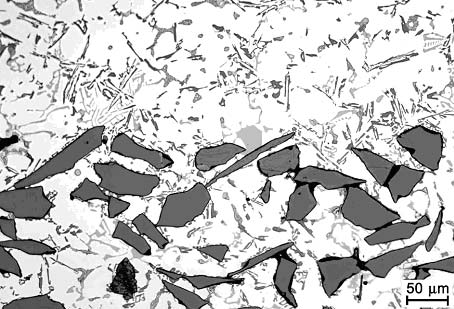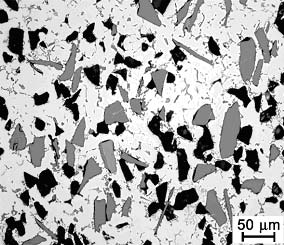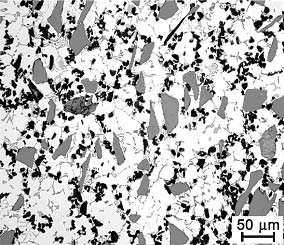|
Metal matrix composites (MMCs) are compound materials whose microstructure consists of a metallic alloy into which a particular reinforcing component has been introduced.
MMC = metal + reinforcement |
The metal alloys in the matrix can be reinforced with:
-
particles (e.g. aluminium oxide, silicon carbide, ...)
-
long fibres (e.g. aluminium oxide, silicon oxide, ...)
-
short fibres (e.g. aluminium oxide, silicon oxide, carbon, ...)
-
whiskers (e.g. aluminium oxide, silicon carbide, ...)
-
mixtures of particles and fibres (hybrid reinforcement)
An aluminium alloy is used most frequently as the metal matrix. Magnesium and copper are, however, finding increased use.

Figure 44: Manufacture of an interpenetrating structure
The first step of manufacture is to prepare porous ceramic pre-forms, whose open porosity is deliberately adjusted to values of between 25 and 75 per cent by volume. These pre-forms are then heated to above 500°C, and passed to the infiltration process. The molten metal then penetrates through the porous ceramic network, solidifies, and creates an interpenetrating structure with the reinforcing components. This makes it possible to manufacture components only part of which contains reinforcement – at precisely the locations where improved material properties are required.

Figure 45: Microstructure showing partial reinforcement
with a transition in the material
MMC materials are generally tailored precisely for the specific application. This is achieved by varying the type of particle or combinations of particles, the proportion by volume, the particle sizes and the porosity in order to meet the requirements of the infiltration process and of the composite material. Fibres can be included, as well as particles, particularly to increase the toughness of the material.
 
Figures 46 and 47: Examples of MMC microstructures
The goals of application-specific microstructure design may include:
- increasing the mechanical strength,
- affecting friction and wear (tribology),
- affecting the thermal expansion,
- improving thermal stability,
- retaining weight reduction through lightweight construction or achieving low density,
- permitting further processing and machining.
Possible applications for MMC materials include the running surfaces of cylinders in vehicle engines, cavity edges on engine pistons, brake ining carrier plates (weight), bearings (thermal expansion), connecting rods (weight), brake discs for motorbikes or railway applications, sports items such as golf club heads,
tennis rackets or the frames of mountain bikes, and cooling plates in electronics.
|
|

